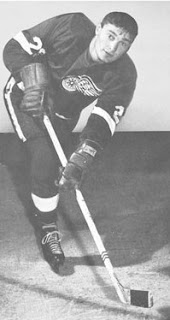Today, the movers and shakers representing 30 NHL franchises, gather in Minnesota for the NHL Entry Draft. The event is considered to be one of the most important on the NHL calendar. Player selections made this weekend will help mold rosters and provide a ray of hope for the future.
The concept of an amateur draft for hockey was conceived in the Original Six era. The National Hockey League wanted to move away from having it's members sponsoring amateur clubs. Back in the day, Montreal and Toronto maintained a huge advantage when it came to securing young talent. Parents and their off-spring, given a choice, would elect to sign with the Canadiens or Maple Leafs. By doing so, they would be living the dream of every youngster who ever laved-up a pair of skates.
In order to spread out the talent pool, President Clarence Campbell convinced the owners to go along with his idea for an amateur draft. It was Campbell's theory that with each team getting a decent slice-of-the-pie, it would make for a stronger league. The weaker clubs, being first-in-line when the draft took place.
The first draft was held on June 5, 1963, at the Queen Elizabeth Hotel in Montreal. NHL general managers could select individuals who were born between August 1, 1946, and July 31, 1947. Basically, making it a draft of 16 year-olds. These kids were not on clubs sponsorship lists as of May 1, 1963.
As one can imagine, at this stage of the game, most prospects who showed any degree of skill or promise, were already under the control of an NHL club.
The selection order was based on league standings following the 1962-63 campaign. Perhaps, taking a glimpse into the future, Montreal appeared in the number-one-hole instead of the Boston Bruins who finished in the cellar. In subsequent drafts, the Habs demonstrated the ability to maneuver up-the-ladder to secure their desired draft choice. Remember Guy Lafleur in 1971?
In 1963, the Montreal Canadiens selected centre Garry Monahan with the number one pick. The rest of round one went like this.
2, Peter Mahovlich (Detroit)
3. Orest Romashyna (Boston)
4. Al Osborne (New York)
5. Art Hampson (Chicago)
6. Walt McKechnie (Toronto)
The entire draft lasted four rounds. In round three, Detroit passed on making a selection, perhaps serving as a commentary regarding the slim pickings. In round four, it was Chicago's turn to refrain from participating. Of interest, only five players made it to the NHL - Monahan, Mahovlich, McKechnie, Jim McKenny and Gerry Meehan.
As noted in the above headline, 21 twenty-one players were selected. The fee for each transaction was $2000. In a strange twist, names of those chosen in the draft, were not immediately made known to the press. According to NHL rules, the players couldn't be moved without their consent. Also, the clubs couldn't approach their new prospects about turning professional until they turned 18. When a player reached this age, his rights owner would have 72-hours to place him on a negotiation or A-form list.
 |
| Peter Mahovlich |
The coach in Hamilton was the legendary Eddie Bush. "He makes better moves now than Frank did when he was a Junior," Bush was quoted as saying in the story. "His weakest point is checking, but he can skate, shoot and stickhandle. If the kid wants to be an NHLer, I think he can," Bush said in describing Mahovlich's strengths and weakness.
In addition to the new amateur draft, teams took part in the Intra-League Draft. The most active club in this regard was Detroit. The Red Wings claimed Irv Spencer (Boston), Ted Hampson (New York) and Art Stratton (Chicago). At the time, Hampson played for Baltimore in the AHL, while Stratton skated for the Buffalo Bisons.
The other news from the 1963 meetings concerned Doug Harvey, who was left unprotected by the New York Rangers. No other club decided to take the plunge for his services. As Boston general manager Lynn Patrick put it, "There were 50,000 reasons why we didn't take Harvey." The 50,000 being a reference to Harvey's $30,000 salary, plus $20,000 for putting in a claim.
The trade of the draft, involved Harvey's current and former NHL teams. In a blockbuster deal, the Canadiens sent Jacques Plante, Phil Goyette and Don Marshall to the New York Rangers. In return, Montreal obtained goalie Gump Worsley, Dave Balon, Len Ronson and Leon Rochefort.
On the coaching front, Billy Reay was hired by the Chicago Black Hawks to replace Rudy Pilous.
The Hockey Hall of Fame named four new members. In the officials category, Bobby Hewitson became the fifth referee to enter the Hall. Joining the Hall as Honoured Members were three outstanding players - Ebbie Goodfellow, Joe Primeau and Earl Seibert.

No comments:
Post a Comment
Note: Only a member of this blog may post a comment.